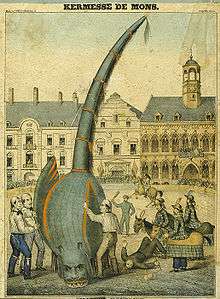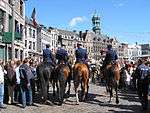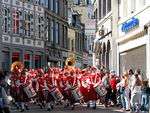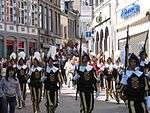Ducasse de Mons

The Ducasse de Mons or Doudou is a popular festival that happens every year on Trinity Sunday (57 days after Easter) in the town of Mons in Belgium. It is recognised as one of the Masterpieces of the Oral and Intangible Heritage of Humanity since November 2005.
The feast comprises two important parts:
- The procession, the descent and the uprising of the Waltrude’s Shrine.
- The combat of Saint George named Lumeçon;
History


The Doudou originates in the Middle Ages. In 1349, because the city of Mons was touched by the plague, the authorities decided to organise a procession with the shrine of Waltrude. The shrine was brought to Casteau (a little village located between Mons and Soignies that has been the location of SHAPE since 1967). At the same time, the shrine of Vincent Madelgarus (husband of Waltrude) that is based in Soignies was also taken to the same place. A miracle happened and the plague disappeared after this Procession. In 1352, the date was fixed on Trinity Sunday. After 1380, the fraternity of Saint George has appeared in the procession. The reconstitution of the combat between Saint George and a Dragon took his place in the feast. Because of the ’’less religious’’ origin, the combat was excluded from the procession in the 19th century. The separation between the religious parts of the feast and the non religious began at this time.
The procession did not take place during the French revolution, in 1803 and during the two world wars.
Planning
The feast begins from the Saturday before Trinity Sunday to the next Sunday. As an eight-day festival with a specific liturgy, it can be called an octave.
The Procession
The descent of the shrine takes place on the Saturday evening. During a religious ceremony, the shrine is taken down from its Altar. The Priest gives the shrine (kept all year in the church) to the town authorities for the duration of the festival. Then a procession with torches begins in the streets of the town.
On the morning of Trinity Sunday, the shrine is placed on the Car d’Or, which is a gilded dray, and the procession begins. The Car d’Or is pulled through the streets by draft horses. The carriage is accompanied by several guilds that represent the history of the region. At the end of the procession, the Car d’Or has to climb a steep, cobblestone street, the Rampe Sainte-Waudru. To help the horses with the immense weight, hundreds of people gather behind to push. Local superstition holds that if the Car d'Or doesn't reach the top of the hill in one go, the city will suffer great misfortune. This happened in 1803, due to the French Revolution, in 1914 and in 1940, just prior to the First and Second World Wars.
At the end of the week, the shrine is returned to its rightful place in Sainte-Waudru Collegiat Church with great ceremony.
The game of Saint George

.jpg)
This game is played on the Trinity Sunday between 12:30 (p.m.) and 15:00 (1 p.m.). It represents the fight between Saint George (the good) and the dragon (the evil). The fight is called Lumeçon. This name comes from the old French name Limaçon (old French name meaning a spectacle with horses that made circular movements.) The combat happens on the central square of Mons. The length of the dragon is about 10 metres. The end of his tail is covered with horses' hairs (mane). The dragon is displaced with the help of the white men (fr:Hommes blancs). Saint George is protected by the Chinchins who represent dogs. The dragon is helped by the devils (French: Les diables). Each devil is armed with a cow bladder full of air (the balloon in the past before plastic had been developed). With this weapon, they knock the Chinchins and the public that are placed all around the arena. The dragon attacks Saint George with his tail. The dragon gives also attacks the public. So the public is also an important participant in the fight. People try to take the mane of the tail because it is said to bring luck for a year. Finally, there are also the Leaf men (fr:Hommes de feuilles) that are covered with real leaves of ivy. They help the dragon by defending and supporting his tail. The combat is precisely choreographed. Saint George on his horse turns clockwise. And the dragon turns in the other direction. (This is a reference to good versus evil). Saint George tries to kill the dragon with his lance but the lance always breaks on contacting the dragon's skin. Saint George uses a pistol and finally kills the dragon on the third try. At 13:00 (1 p.m.), the participants leave the square, people rush into the arena to find the last lucky manes which have fallen on the ground. And the carillon of Mons rings.
Other information
- A big concert is organised the Friday evening before Trinity on the central square of Mons.
- Military bands from all over the world play concerts every day in Mons.
- A braderie (street clearance sale) is organised on Monday.
- Another combat is organised on next Sunday. The combat is reserved for the children (Public and actors). The dragon is lighter than the original.
- The streets of the centre of the town are a pedestrian zone during the festivities. These streets are full of people listening to music, eating Belgian chips, barbecue, and drinking a lot of Belgian beer and soda.
Gallery
-

-
-

-

-

Shrine on the Car d'or
-
.jpg)
The Iron man.
-
The little dragon for the kid's day
-
A fraternity named Beubeux.
-
Peoples after the combat on the central square.
-

The shrine.
-
Car d'Or on the central square.
-

Uprising of the Car d'Or on the rampe Sainte-Waudru.
Dates
- 2015 : 31 May
- 2016 : 22 May
- 2017 : 11 June
- 2018 : 27 May
- 2019 : 9 June
External links
- (French) Official website
- (French) Official website of the city of Mons about Ducasse